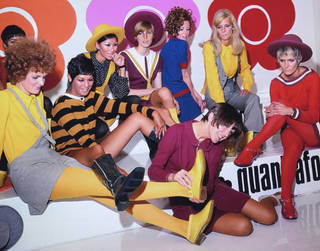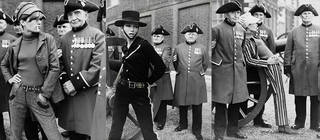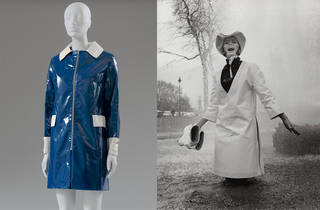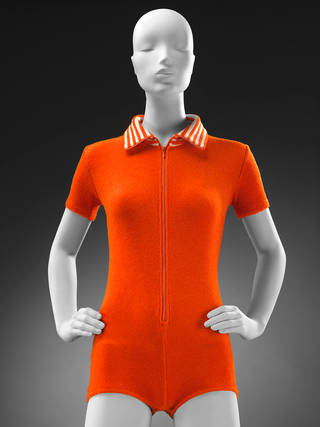Modern fashion owes a great deal to the trailblazing 1960s designer Mary Quant (1930 – 2023). From skinny-rib sweaters, to coloured tights and 'onesies', here's our round-up of the signature Quant looks which revolutionised the way we dress, proving there was more to Mary than just miniskirts.
The jersey dress
Of all the fashion revolutions that happened in the 1960s, the boom in knitted jersey fabrics had the most impact on how we dress today. The miniskirted and modernist silhouettes of the sixties, and the later cling and swing of the seventies, were all – quite literally – shaped by the meteoric rise of jersey. Quant was the figurehead of the jersey dress boom, producing thousands of designs in hundreds of different colours and permutations, including different shaped collars, sleeves, zips and buttons, with skirts swishy or straight.

Frame-knitted jersey fabric, or 'stockinette', had been used for the production of underwear and stockings since the 17th century. Chanel had used a heavier version of the fabric for daywear in the 1920s and 30s, but it was after the Second World War when synthetic fibres became cost-effective for use in mass-produced fashion. New fabrics like Crimplene and Acrilan were produced at high speed on knitting machines which were up to ten times more efficient than traditional looms. This cost-effectiveness enabled manufacturers to respond more quickly to changes in fashion, and the fabric also required less precise fitting, leading to quicker production.
Quant saw the potential for easy jersey garments as outerwear. Pullover pinafore jersey dresses were a key part of Quant's first Ginger Group collection, launched in the autumn of 1963, and were significantly cheaper than her tailored wool dresses. Bonded wool jersey (made of a 100% wool single-knitted jersey, heat-bonded to an acrylic-knitted backing) soon became her go-to option, providing the stretch and structure she required for her distinctive minidresses and simple shifts. Quant's jersey dress had a media moment when the designer sported a cream and navy version to receive her OBE from the Queen in November 1966, standing out among the sober-suited crowd. Practical, affordable, crease-resistant and colourful, the jersey dress became a driving force in the democratisation of style.

Tights
Where would the modern women be without stretchy tights, in black, or a choice of colours? Sixty years ago, most women were still unquestionably wearing stockings in the shade 'American Tan' (black stockings were a hangover from the Victorian era). Held up by garters, or attached to a separate suspender belt with hard metal clips, stockings were fiddly and uncomfortable to wear. Skirts meanwhile fell below the knee to keep all this hardware, and naked thighs, firmly hidden from view.

By the autumn of 1963, tights in colours as well as black were available at the British store Marks and Spencer, but it took several years for them to catch on (at 12 shillings a pair in 1966, they were around three times as expensive as stockings). Mary Quant, always looking to develop new ideas, wanted stockings and tights in bright mustard yellow, ginger and prune, as well as black – the perfect accompaniment to her knee-skimming skirts and dresses which enabled women to dance, run and move. She partnered with the Nylon Hosiery Company, set up in 1954 by the Curry family, who had recently emigrated from India. They developed a technique of making long stockings which joined together at the top, and were specially dyed to contrast and co-ordinate with Mary Quant separates. The partnership proved to be long-lived, with an ever-expanding range of new colours and patterned knits, including the 1966 'Highball' glitter stockings in silver, gold, green, blue and red.

The distinctive Mary Quant packaging, with its instantly recognisable daisy logo, helped such products to stand out among competitors. Quant, who was by this point a media star, implicitly promoted her own tights, wearing them for press and marketing events around the world. By the 1970s, tights were more popular than stockings. An article in the Sunday Times from 1973 suggested that while Quant hadn't invented fashion tights, she was the reason most women wore them. Her hosiery line continued into the 1980s, making it one of her most enduring enterprises, and perhaps the most revolutionary, yet underappreciated, of her ideas.

Trousers for women
From skinny jeans and culottes to harem pants, bell bottoms and power suits, trousers have been an essential part of fashionable women's wardrobes for over 50 years. This was thanks largely to Mary Quant, who was one of the first designers to promote trousers and suits as fashionable womenswear.

Historically, trousers were largely seen as a 'male' garment in many cultures, with strict rules prohibiting women from 'cross dressing'. By the 1880s, western women were starting to wear trousers for leisure activities like horse riding and cycling. Hollywood movie stars Marlene Dietrich and Katherine Hepburn chose to wear them on and off screen in the 1920s and 30s, despite fierce condemnation. During the Second World War, trousers were becoming socially acceptable, as more and more women donned uniforms and joined the workforce.
When Quant opened her famous boutique, Bazaar, in London's Chelsea in 1955, trousers and jeans were popular with female students and subcultures on the outskirts of mainstream fashion. However most women still only wore trousers at very informal occasions or in private. Quant designed spotty pyjama-style cropped trousers in 1955. Her collections from the early to mid-sixties featured breeches, knickerbockers (men's baggy-kneed trousers popular in the early 20th century), dungarees and fashionable trousers which were worn with midriff-bearing tops or oversized sweaters.


Appropriating trousers for women remained a strong theme throughout Quant's career, as she pushed towards an increasingly androgynous look, playfully challenging established gender norms. Sadly, surviving examples are rarely found now, perhaps because they were so popular and well-worn. A rare pair of trousers called 'Legs Downwards' survives in Mary Quant's own archive. Made from striped worsted wool, the 'Alexander stripe', they clearly borrow from traditional men's tailoring, but are cut with a low waistline, described as 'cowboy style' by Quant.

Towards the end of the sixties, Quant's range of trousers provided a useful alternative for those who felt uncomfortable wearing increasingly short skirts. Quant was a great advocate of wearing trousers for all occasions and was often photographed in masculine styles, helping to popularise an increasingly informal, androgynous style.

The skinny-rib sweater
In the 1950s, aspiring Beatniks (a fashionable subculture associated with art and poetry) had borrowed men's sweaters to achieve a loose, sack-like silhouette. But the tweed shift dresses and pinafores that retailed in Bazaar required a different look. As with many of Quant's designs, the inspiration for the skinny-rib came from childrenswear. In her 1966 autobiography, she describes how she "pulled on an eight year old boy's sweater for fun" and was "enchanted" with the result. Six months later, Quant had put the skinny-rib into production and "all the birds were wearing the skinny ribs".

Pinafores paired with sweaters were the building blocks of Mary Quant's Ginger Group – the wholesale label she set up in 1963, which promoted good-value, mix-and-match separates. By autumn 1964, the collection included 'Adam's Rib', a skinny sweater with three-quarter length sleeves available in black, pink and jade knitted wool. Quant showed how the sweaters could be worn with a matching woven check jacket and skirt to create a more relaxed version of business dress. In America, Quant's ranges for the J C Penney mail-order catalogues included the 'String Bean' sweater, with mock-turtleneck and long sleeves, it "perks up so many of your outfits!".
Since the 1960s, the skinny-rib sweater has retreated and returned as a practical way of adding contrasting colour to a winter outfit. No original Quant or Ginger Group skinny-rib sweaters have been found to date, suggesting they were so useful that they were worn to bits! Of all Quant's inventions, it is perhaps the ultimate functional, unisex and modern garment.
PVC rainwear
Since when did raincoats go wild? Since Mary Quant designed for Alligator.
In the 1960s, Quant was "bewitched" by polyvinyl chloride (PVC), "this super shiny man-made stuff and its shrieking colours… its gleaming liquorice black, white and ginger." (Quant by Quant, 1966). The plastic-coated cotton was a new material in the fashion world, having previously only been used for protective garments. Quant launched her 'Wet Collection' in April 1963 at the Hôtel de Crillon, Paris, featuring entirely PVC garments. The show was attended by influential fashion editors, and it earned the designer her first magazine cover for British Vogue, featuring a brilliant-red PVC rain mac. Many fashion buyers immediately placed orders for the space-age garments, but production issues with sealing the PVC seams delayed the collection's launch on the high street. The material was so innovative that it took another two years before a collaboration with British manufacturer Alligator Rainwear resulted in a commercially viable range of Mary Quant PVC raincoats.

Based in a mill in Stockport, near Manchester, Alligator had produced traditional weatherproof coats for decades in black, brown and beige to suit the British climate. By signing a licensing deal with Mary Quant, the brand took on a new lease of life, developing a bright new range of waterproofs in primary colours. The coats combined functionality with striking visual effects – capes, zips and contrasting collars and cuffs. Quant was ever experimental, pushing Alligator to try more innovative synthetic materials like nylon to produce exciting new looks.
Loungewear and hotpants
Writing in 2012, Quant recalled how she discovered the 'house-wear' market in the US around 1965 and decided to bring this new concept to Europe. She designed "a collection of jersey tops and hotpants in striped jersey-knit fabrics with matching bras, pants, socks, leg warmers and minis – all using knitted fabrics of various thicknesses and weights". The idea of special clothes for lounging in at home was quite a change in mindset for most of the British public – who only had the ubiquitous dressing gown until then.

Equally, department stores were "bemused" as to which section to sell them in. "Was it hosiery or knitwear or what?"
As I love breaking down barriers all this was great fun. Quite soon this collection was promoted as 'underwear as outerwear' and vice versa.
The range included brightly coloured jersey and stretch towelling one-piece suits, with short zip-up versions and full-length styles that included feet. These easy-to-wear garments were the ultimate in comfort and freedom, made in the fun colours that were at the heart of Quant's brand. Some were designed like an adult-sized Babygro (invented in the US and trademarked in the 1950s), and they show the designer returning to the idea of borrowing from childrenswear. Quant once said, "I didn't want to grow up, perhaps that's something to do with it", reflecting her desire to hold on to the freedoms of childhood and not conform to the restrictions and rules of adult life. Quant's experiments with loungewear can be seen as the forerunner to the contemporary 'onesie' craze.


